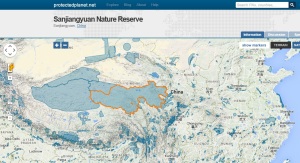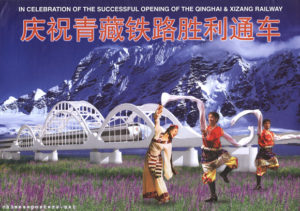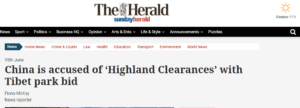UNESCO’s World Heritage Committee has dutifully rubber-stamped China’s application to declare a further 60,000 sq. kms of the Tibetan Plateau to be branded with World Heritage status.
Politics has trumped facts on the ground, inconvenient facts such as China’s removal of most of the Tibetan nomad guardians of the Koko Shili landscape to remote concrete settlements on industrial urban fringes, with nothing to do, dependent on state handout rations.
Inconvenient ground truths, like a long history of Tibetan wildlife rangers risking (and losing) their lives to protect Koko Shili endangered antelopes, don’t stand much chance of prevailing, as the basis of making decisions, in today’s world.
When it came to the crunch, the 21 ambassadors of the 21 countries currently on the World Heritage Committee decided not riling China matters more than anything Tibetans might say. That’s how it is these days. The Tibetans might have truth on their side, but that is all they have.
Tibetans and International Campaign for Tibet did get to speak up, while there was still time to hope for an outcome based on the actual needs of the Tibetan Plateau landscapes, the decimated antelope herds, and the Tibetan rangers who fought the poachers during the decades when China’s party-state showed no interest in the wild west beyond the frontier.
Tibetans did vigorously put the case that protection should mean actual protection, both for the iconic antelope, and for the Tibetans whose pastoral landscapes included Koko Shili every summer, and for the entire habitat and all species who use it. Both in private and formally, before the World Heritage Committee, a skilful Tibetan advocate, professional environmentalist Tenzin Choekyi, spoke up for Tibetan curatorship, stewardship, skilful land use, sustainable ways of mingling wild and domestic herds, and Tibetan values that have done more, over far longer, to conserve wildlife than any official branding and administration from above.
That lobbying got results, behind the scenes, if not at crunch time in the actual vote. In private, there were admissions that UNESCO and its IUCN eyes and ears on the ground in Koko Shili do know there are many problems inherent in China’s nomination, and with its’ insistence that Koko Shili is “no-man’s land” devoid of human presence, a virgin landscape awaiting the arrival of modernity with Chinese characteristics.
International Union for Conservation of Nature (IUCN), to whom the cash-strapped UNESCO outsources the scientific verification of nominations, is now perhaps embarrassed by its willingness to sign off, despite many misgivings. Bureaucrats indicated a weary familiarity with China throwing its weight around, and with World Heritage Committee decisions being little more than a rubber stamping of agendas served up by officials.
Even if individual officials did have reservations, did understand that China had airbrushed away the decades of Tibetan care for Koko Shili and the antelopes, they still had to take their instructions from the foreign ministries that appointed them.
Which government these days would stand up to China, on an issue that is not even in the headlines, which has only truth on its side? If any of those ambassadors went to the trouble of briefing head office back in Luanda or Warsaw, Helsinki or Jakarta, Ankara, Dar-es-Salaam, Hanoi or Almaty, the instruction would come back: if we have to publicly contradict China, we do so extremely selectively, on issues that deeply matter to our own domestic audience, so don’t get ideas about bucking the system.
So does it matter that Tibetans got to speak for Tibet? If might is right, China’s rise and rise is endless, is there any point in speaking up? If even the mighty US of A must accommodate China’s rise, how can Tibetan voices expect to be heard? When China can hound a Nobel peace prize winner to death, and governments barely mutter in protest, how do Tibetans get traction?
On the day, what world attention was focussed on was the first meeting of Trump and Putin, how to press China to rein in North Korea, and whether the G20 club of the world’s most powerful countries could agree on anything beyond platitudes. If politics trumps truth, geopolitics is nakedly open about being about power, nothing to do with ground truth.
In such a world, what can Tibetans do? Actually, the world has always been thus, no matter how much certain vested interests now talk of a rules-based order. It’s just more obvious now that might is right, winning is all, nobody likes a loser. This is the modern world, into which China ejected the Tibetans back in the 1950s, three human generations ago. Tibetans have learned not just to survive, but to be at home, anywhere in the world, to adapt to modernity and thrive. As the Dalai Lama has often said, this is a long process, spanning generations. In a violent world, foregoing violence inevitably means the Tibetan cause is a long one, frequently gasping for oxygen when conflicts suck it all.
Long term nonviolent conflicts need long term approaches. Too many in the Tibet movement repeat the strategies learned one or two decades ago, when the world did listen, as if little has changed. We can no longer expect anyone to listen when we show our pain over repression, torture, prisoners, injustice and repression. The audience has faded away. We now need to recognise what issues people do focus on, what does motivate them, what does activate their values, and introduce Tibet as one aspect of that issue. That way we gradually gain new audiences, new allies, brought together by shared interests.
Perhaps the most famous of all slogans of the Dalai Lama is: Never Give Up. One might add: never follow the same sun beaten path out of habit, when it no longer works. Try a fresh direction, fresh approach, fresh audience, without expecting quick results.
The decision by the World Heritage Committee says much about what we may grieve for on our paths old and new. The rubber stamp of anything proposed by China is axiomatic, and has little to do with heritage. It would be great to believe that official protection, by a UN agency, actually means protection, for wildlife, for whole habitats and landscapes, and for the human guardians of those wild animals. What could be more self-evidently a good thing than world heritage?
In reality, as Tibetans discovered while lobbying at the World Heritage Committee meeting in Krakow, the United Nations strength is also its’ weakness: it is a club of nations, of sovereign states with a shared agenda of aggrandising state sovereignty, reputation and brand equity; using the agencies of the UN to burnish their credentials. UNESCO World Heritage status used to mean the most precious places –both cultural and natural- would actually get international help to maintain the values that make them special. As the world has become more selfish and violent, so too has the UN become powerless, its agencies starved of funds, its reputation all that is left of what once embodied the hopes of the world. UNESCO has been especially hard hit, over a long period, by the deep suspicion of western donor states that it became an agency beholden to its third world majority rather than to its funders.
We now find ourselves in a world where China regularly nominates Tibetan landscapes for World Heritage listing, which is automatically granted, whereupon China’s new rich monetise World heritage status for their own wealth accumulation, as happened first at Jiuzhaigou in northern Sichuan. China nominated the Three Parallel Rivers of the Tibetan portion of Yunnan, while taking care to define the World Heritage boundary to exclude the actual rivers, leaving China free to dam the Yangtze, Mekong and Salween Rivers, and install power grids carrying ultra-high voltage electricity to distant Chinese factory cities, leaving UNESCO World Heritage Committee helpless to object.
.China has announced it will next year nominate the whole Lhasa old town to become World Heritage, even though there is hardly an old building left intact in old Lhasa. Almost all have been demolished or gutted and renovated, fitted out as upmarket boutiques with new Tibetanesque exteriors, part of the Lhasa master plan to sell premium priced Tibetiana (sourced from Kathmandu), sold by Chinese businesses presenting a Tibetan face to the tourist customers. Almost every aspect of this rebranding exercise offends UNESCO World Heritage standards for properties designated as cultural heritage, which emphasises repair and preservation of old buildings, and is strongly against knocking down the old to be replaced by “authentic replicas”, as they are called in Chinese.
In 1992, when UNESCO’s World Heritage Committee accepted Jiuzhaigou into world heritage status, and in 2003 when its inscribed the Three Parallel Rivers minus the actual rivers, and now in 2017 in accepting China’s nomination of Koko Shili “no-man’s land”, UNESCO has shown a willingness to let China dictate how Tibetan lands are framed, defined, what is excluded and included, leaving China free to accumulate wealth and power from Tibet, while UNESCO’s experts privately fume and splutter helplessly.
Crunch time is 2018, if, as announced, China proceeds with nominating “old” Lhasa. Architectural heritage motivates many more people than natural landscapes and nomadic populations. Will the experts speak up? Will Tibetans be able to mobilise support? Will UNESCO at last realise that its foundational premise, of the first world benignly preserving the monuments and pristine landscapes of the impoverished third world, is thoroughly out of date, nowhere more so than in China?
As China steadily advances its goal of capturing UN agencies, if only to silence them, as in the Human Rights Council, when will we decide, in a violent, thuggish world, that there is more to being right than might?
Sometimes all it takes to reframe the issue, to make the remote suddenly familiar, is a sentence, even a couple of words that cut through. Staying with remote Koko Shili –so remote most Tibetans aren’t sure where it is- the killer app that made the unfamiliar familiar turned out to be two well-chosen words found by the Glasgow-based Herald Scotland, that resonated with its Scottish readers. Seeking to explain not only China’s plans for Koko Shili but for most of the Tibetan Plateau to be declared national park, the Herald said it is like the Highland clearances.
In an instant, Scottish readers could not only get it, connect with far Tibet, but also sympathise, drawing on the living memories of past generations of Highland Scots evicted from their lands, farms and crofter way of life by alien English landlords following the final conquest of Scotland in 1745.
Those memories of displacement and dispossession, of impoverishment and migration to all corners of empire, of loss of all that was dear, to please English aristocrats who fancied castles surrounded by unpeopled windswept heathlands suitable for stag hunting. This is the root of today’s Scottish nationalism.
Even if you aren’t of Scottish heritage, don’t have the Highland enclosures imprinted in race memory, it takes only a sentence or two to evoke the pain of families ruined and pushed asunder by what we would today call the inexorable forces of globalisation.
In a moment, such is the power of memory and imagination, we know what Tibetan nomads of Drito, Chumarleb and Koko Shili, herded off their pastures like animals, are going through. In an instant we hear their laments, like the dirges of those ancestral Highlanders. This cuts through not only time and distance, but also the hyperscientistic language of China’s claim to Koko Shili as a bright new scientific object.
One telling metaphor can reframe everything, regaining a human perspective on an issue presented as a policy project of state power plans to attain an objective of biodiversity conservation. Those two words cut through all the jargon, the hundreds of pages of Chinese official reports on the geology, hydrology, ecology, species dynamics etc. etc. of Koko Shili.
Not only can the right metaphor reset the terms of debate, our understanding of what is at stake, it rehumanises the abstract, brings home the lifeworlds of those afar.
More than that, the apt word app brings fresh, deeper understanding. This goes beyond sympathy, into fitting us with a fresh frame of reference, that explains to us our contemporary world. How so?
The depopulation of the Scottish Highlands, more recently the tundra of Siberia, or the pasturelands of the Tibetan Plateau are all examples of the new economy displacing the old economies of productivism, of farming and livestock production. The new economy has the uncanny knack of monetising the end of productivism, replacing the self-sufficient farms, herds of yaks, gangs of timber cutters with tourism, romantic vistas, consumption of landscape as object of desire and projection, by a monied class motivated by wanting to make a lifestyle statement. This is the genius of the post-industrial, post-productivist economy: consumption has become the new production. The ruins of the Highlands crofters’ cottages only make those highlands more romantic. Even Donald Trump might decide to build an upmarket golf course there, if only the view is not unromantically blighted by hitech windmills.
In a moment, we recognise not only that the remote is near, but that the problem is globalisation, and the accumulation of wealth by a small elite, who have been telling us for decades that this will benefit all, only we no longer believe them. Of a sudden, the rebranding of Koko Shili as ecotour packaged wildlife adventure land becomes legible, familiar, just another epic scaled theme park for the new class of new rich to make money, by persuading us to consume.
Quite often, I am contacted by journalists based in Beijing, Shanghai and Hong Kong, puzzled by the latest Chinese propaganda boasting how much of Tibet is officially declared to be national park, even world heritage. Their puzzlement is because they know the picture presented by exiled Tibetans is that China’s 60 years in command of Tibet has been 60 years of rape of the land and its resources. As author of a book on mining in Tibet, they turn to me, to clarify their thinking. How come China is now boasting of how much of Tibet is locked up, thus excluding the miners, in the name of wildlife protection? What are we to make of the ever expanding nature reserves? Is it no longer true that China is stripping Tibet of its mineral treasures?
Actually, there is no incompatibility. Mining happens in specific, smallish enclaves where the mineral concentrations are exceptional. Traditional pastoral production is the opposite, making best use of vast, extensive pastoral lands that are sustainably productive as long as the nomads are mobile, moving on before the grasses are exhausted. Likewise, the new economy of tourist consumption of wilderness landscapes requires huge areas that maintain the illusion of pristine “no-man’s land”, to use China’s repetitive cliché. Whether the product for consumption is highland whisky made from pure highland water, or a glimpse of the highland grouse or stag at bay, or a glimpse of Tibetan antelopes on their way to their Koko Shili birthing grounds, it is the same new global economy of mass consumption, and wealth accumulation for the powerful. The foreign correspondents based in Beijing do see all around them the new economy of consumption alongside the old factory economy, but somehow the old image of Tibet as a resource extraction zone, and the new image of depopulated Tibetan wildscapes repurposed for iconic snaps of iconic wildlife, still need reconciling.
Now we find ourselves right at the heart of what matters most in today’s world, what drives the popular rejection of the same old politics of centre-left and centre-right neoliberal domination of democratic countries. The new populism, whether of the right or left, that is sweeping aside the old parties, and support for globalisation, took decades to emerge, but ordinary folks have awoken.
We do live in a violent, thuggish and unpredictable world. Might is right, until it is wrong, and we see through the lies and the promises that are never fulfilled. Tibet might seem very far away, yet it illuminates what is close to home. Those who speak for Tibet need to find those new metaphors that wake us up.




2 replies on “RUBBER STAMPING CHINA’S TIBET”
[…] Gabriel Lafitte observed: “Politics trumped facts on the ground, inconvenient facts such as China’s removal of most of the Tibetan nomad guardians of the landscape to remote concrete settlements on industrial urban fringes, with nothing to do, dependent on state handout rations. The decision by the World Heritage Committee says much about what we may grieve for on our paths old and new. The rubber stamp of anything proposed by China is axiomatic, and has little to do with heritage.” […]
[…] Gabriel Lafitte stelt vast: “De politiek won over feiten op de grond, ongemakkelijke feiten, zoals het verwijderen van het grootste deel van de Tibetaanse nomaden van het landschap naar afgelegen betonnen nederzettingen op de industriële stadsranden van China, met niets op te doen, afhankelijk van door de staat uitgereikte rantsoenen. Het besluit van het Werelderfgoedcomité zegt veel over wat we kunnen treuren over onze oude en nieuwe paden. De klakkeloze goedkeuring van alles wat China voorstelt heeft weinig te maken met het beschermen van erfgoed.” […]